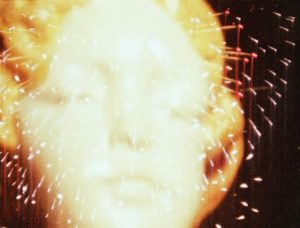‘This concept of images which are a collective of images or experiences that then make up a whole experience is something that I’ve worked on most of my life’ – Bruce Conner
Following presentations of Bruce Conner’s films such as CROSSROADS (1976) in June 2015, A MOVIE (1958) in May 2017, and EASTER MORNING (2008) in Naples, January 2018, Thomas Dane Gallery introduces BREAKAWAY (1966) to a London audience for the first time. Conner was one of the foremost American artists of the twentieth century, whose transformative work addressed facets of post-war American society, from a rising consumer culture to the dread of nuclear apocalypse. Working in a range of media, Conner created photography, collage and graphic work alongside hybrids of painting and sculpture, film and performance. Conventionally lesser known within this diverse practice were Conner’s films, which have been reappraised as an iconic, experimental and independent body of work.
Conner began making short-films from the late-1950s and created BREAKAWAY in 1966. The film comprises two distinct halves which feature the performer, choreographer and singer Toni Basil. In the five-minute film, Basil dances against an empty black background to her Motown-inspired pop song ‘Breakaway’, released in 1966. Dancing through various states of undress, Basil’s performance is intensified by Conner’s cinematography and camera effects including: stroboscopic effects, quick-cut edits, and diverse frame rates. The alignment of Basil’s performance and Conner’s stylization of motion defined what some consider to be a prototype for the modern music video.
In the second half of BREAKAWAY, everything that has been recorded is repeated backwards, including Basil’s song which devolves into a distorted version of the original. Fellow filmmaker and contemporary Stan Brakhage called the reversal a ‘contravision’, as Basil’s movement transforms into graphic entropy and psychedelia. In one sequence, Basil wears a diaphanous white slip which intensifies the spectral quality of her body. Coupled with Conner’s sharp contrasts in light, accelerated frame rates and chaotic zooms, Basil becomes abstracted, threatening to dissolve almost entirely from view. In this optical overload, ‘what remains is crackling energy,’ as author and curator Gerald Matt writes, ‘a magnificent visual-musical play of light, a hymn to freedom.’ Conner’s reversal of content constitutes a reflection on the medium itself. As Kevin Hatch writes in Looking for Bruce Conner, BREAKAWAY registers ‘the hysteria of film, the hystericization of the cinematic apparatus itself, as it attempts to capture the plenitude of the present.’

Conner’s manipulation of the soundtrack is reminiscent of the ‘backmasking’ techniques popularised by The Beatles as well as tape loops used in psychedelic rock. This combination of image and music paralleled changes in counterculture between the early and late 1960s. These included the abstract experiments with expanded media at the San Francisco Tape Music Center as well as Conner’s involvement in psychedelic light shows at the Avalon Ballroom, similarly constructed around rock improvisation. Cumulatively, Conner’s use of deconstruction, acceleration, reversal and abstraction, infers multiple kinds of desynchronisation. As art historian Johanna Gosse writes of BREAKAWAY, the film enacts ‘a release not only from gravitational space and progressive time, but from language itself.’
Using multiple frame rates at dazzling speeds, Conner destabilises Basil’s performance into a state of evanescence, enhanced by the flickering materiality of celluloid which fragments Basil into a phantomic and faintly sinister image. BREAKAWAY illuminates Conner’s polymathic practice as both psychedelic and realist, capable of articulating a meta-critique of popular moving image and reflecting his long-held interest in syncretism through mesmeric cinematography.
Bruce Conner was born in McPherson, Kansas in 1933 and died in San Francisco, California in 2008. Conner received his BFA from Nebraska University before studying at the Brooklyn Museum Art School and the University of Colorado. Conner came to San Francisco on the wave of the Beat Generation of the late 1950s, becoming an active member of the music scene during the late 1960s. In San Francisco, Conner became a singular practitioner within the underground film community and the flourishing San Francisco art world, achieving international status early in his career.
Recent solo exhibitions include: Please Enjoy and Return: Bruce Conner Films from the Sixties, Mexico Art Museum, Albuquerque NM (2018); Bruce Conner: Untitled Prints, Henry Art Gallery, Seattle WA (2018); University of New Forever and Ever, Speed Art Museum, Louisville KT (2017); A MOVIE, Thomas Dane Gallery, London, England (2017); Bruce Conner: It’s All True, Museum of Modern Art, New York NY; travelled to: San Francisco Museum of Modern Art, San Francisco CA, Museo Nacional Centro de Arte Reina Sofía, Madrid, Spain (2016/17) among many others.
For exhibition and sales enquiries please contact François Chantala: francois@thomasdanegallery.com For press enquiries please contact Alex Bennett: alex@thomasdanegallery.com
Gallery hours: Tuesday to Friday 10am-6pm, Saturday 12pm-6pm or by appointment. Admission: Free
Tel: +44 (0) 20 79252505
Nearest Tube: Green Park or Piccadilly Circus
Instagram: @thomasdanegallery Twitter: @ThomasDaneLD
